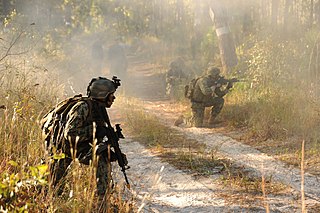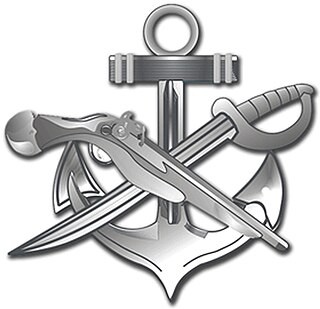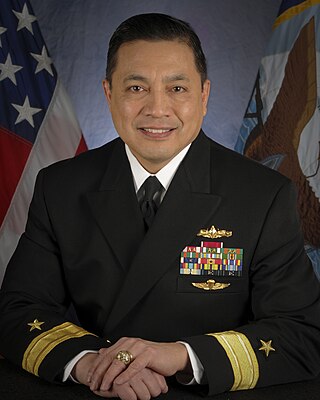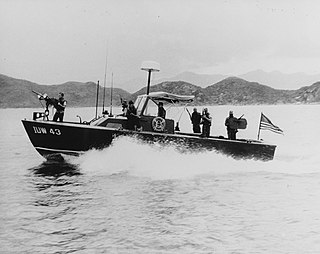The United States Armed Forces are the military forces of the United States. The armed forces consist of six service branches: the Army, Marine Corps, Navy, Air Force, Space Force, and Coast Guard. All six armed services are among the eight uniformed services of the United States.

A coast guard or coastguard is a maritime security organization of a particular country. The term embraces wide range of responsibilities in different countries, from being a heavily armed military force with customs and security duties to being a volunteer organization tasked with search and rescue without law enforcement authority. In most countries, a typical coast guard's functions are distinct from those of the navy and the transit police, while in certain countries they have similarities to both.

A brown-water navy or riverine navy, in the broadest sense, is a naval force capable of military operations in littoral zone waters. The term originated in the United States Navy during the American Civil War, when it referred to Union forces patrolling the muddy Mississippi River, and has since been used to describe the small gunboats and patrol boats commonly used in rivers, along with the larger "mother ships" that supported them. These mother ships include converted World War II-era mechanized landing craft and tank landing ships, among other vessels.

United States Navy Explosive Ordnance Disposal technicians render safe all types of ordnance, including improvised, chemical, biological, and nuclear. They perform land and underwater location, identification, render-safe, and recovery of foreign and domestic ordnance. They conduct demolition of hazardous munitions, pyrotechnics, and retrograde explosives using detonation and burning techniques. They forward deploy and fully integrate with the various Combatant Commanders, Special Operations Forces (SOF), and various warfare units within the Navy, Marine Corps, Air Force and Army. They are also called upon to support military and civilian law enforcement agencies, as well as the Secret Service.

A Maritime Safety and Security Team, or MSST, is a counter-terrorism team of the United States Coast Guard established to protect local maritime assets. It is also a harbor and inshore patrol and security team that includes detecting and, if necessary, stopping or arresting submerged divers, using the Underwater Port Security System. It is the only special force that can arrest submerged divers.

U.S. Coast Guard Port Security Units are Deployable Specialized Forces organized for sustained expeditionary security and anti-terrorism. They provide Anti-Terrorism Force Protection (ATFP) missions, which include harbor and port defense, protection of High Value Assets (HVAs), expeditionary security, Sea Lines of Communications (SLOCs), special missions. and coastal surveillance. PSUs are expeditionary units that conduct OCONUS missions in support of a requesting regional combatant commander. PSUs usually operate under the direction of the Coast Guard's Pacific Area (PACAREA) command but are unique in that they are the only Coast Guard units that can be quickly requested by the Department of Defense.
The United States Coast Guard is the coastal defense, search and rescue, and maritime law enforcement branch of the United States Armed Forces and is one of the country's eight uniformed services. It carries out three basic roles, which are further subdivided into eleven statutory missions. The three roles are:

The EXW qualification is a warfare qualification awarded to enlisted United States Navy personnel assigned to U.S. Navy expeditionary combat units, who satisfactorily complete the required qualification course and pass a qualification board hearing. The program was approved July 31, 2006 by then-Chief of Naval Operations Adm. Michael Mullen.
A Mobile Inshore Undersea Warfare Unit (MIUWU) was a component of the United States Navy's Force Protection Package tasked with providing seaward security to joint logistics over-the-shore operations from either a port or harbor complex or unimproved beach sites. The mobile inshore undersea warfare unit often made up of Seabee rates is equipped with mobile logistics, radar, sonar, and communications equipment located within mobile elements, such as a tent, specially modified HMMWV, or truck-mountable container.

The Navy Expeditionary Combat Command (NECC) is an echelon III command of the United States Navy, which serves as the single functional command to centrally manage current and future readiness, resources, manning, training and equipping of the United States Navy's 21,000 expeditionary forces who are currently serving in every theater of operation. The NECC was established in January 2006. NECC is a subordinate command of the Navy's Fleet Forces Command.
The structure of the United States Navy consists of four main bodies: the Office of the Secretary of the Navy, the Office of the Chief of Naval Operations, the operating forces, and the Shore Establishment.

The Special Warfare Combat Crewmen (SWCC ) are United States Naval Special Warfare Command personnel who operate and maintain small craft for special operations missions, particularly those of U.S. Navy SEALs. Their rating is Special Warfare Boat Operator (SB).

The Maritime Expeditionary Security Force (MESF) is a force within the United States Navy under the organizational structure of the Navy Expeditionary Combat Command. The MESF originated from the Naval Coastal Warfare community which transitioned to the MESF in the early 2000s. The MESF's primary mission is force protection with deployed operations occurring around the world. Anti-terrorism and force protection missions include harbor and maritime infrastructure defense, coastal surveillance, and special missions. Specialized units work together with MESF squadron staffs providing intelligence and communications. MESF units deploy worldwide to detect, deter, and defend an area or unit. Recent locations include the United States, Panama, Korea, Saudi Arabia, Kuwait, Iraq, Afghanistan, Bahrain, United Arab Emirates, and Egypt.
The Riverine Squadrons of the United States Navy are elements of the Navy Expeditionary Combat Command (NECC). According to the Navy: “The Navy’s Riverine force focuses on conducting Maritime Security Operations and Theater Security Cooperation in a riverine area of operations or other suitable area. The force is capable of combating enemy riverine forces by direct fire, or by coordinating supporting fire. It will share battle space with the other Services in an effort to close the seams in Doctrine, Tactics, Techniques, and Procedures, and Command, Control, Communications, Computers, Intelligence, Surveillance and Reconnaissance.”

Marine expeditionary unit (special operations capable) (MEU(SOC)) is a program created by the United States Marine Corps (USMC) and the United States Navy (USN) in 1985 for Marine expeditionary units (MEU). The program enhances MEUs providing them with additional training and equipment to become certified as special operations capable with a Maritime Special Purpose Force (MSPF). The designation special operations capable is unique to the Marine Corps and means in relation to special operations. The role of a MEU(SOC) however is not equivalent to the special operations role of special operations forces. Although considered special operations capable a MEU(SOC) does not form part of the United States Special Operations Command (USSOCOM) established in 1987 or the United States Marine Forces Special Operations Command (MARSOC) later established in 2006.

The Deployable Specialized Forces (DSF) —formerly Deployable Operations Group— are part of the United States Coast Guard that provide highly equipped, trained and organized deployable specialized forces, to the Coast Guard, United States Department of Homeland Security (DHS), United States Department of Defense (DoD) and inter-agency operational and tactical commanders. The command was formerly headquartered in Arlington, Virginia where it was established on 20 July 2007, and was commanded by a captain. It was decommissioned by the Commandant of the Coast Guard, Admiral Robert Papp on 1 October 2013, with units previously assigned to the DOG being split between Coast Guard Pacific and Atlantic Area commands. The units were subsequently reorganized under Deployable Specialized Forces (DSF).
The Coastal Riverine Force (CORIVFOR) is a unit of the United States Navy within the organizational structure of the Navy Expeditionary Combat Command (NECC). The unit was established following the merger of Riverine Group 1 and the Maritime Expeditionary Security Group 1 & 2 on June 1, 2012. Its express purpose is to provide port and harbor security, and offshore protection for maritime infrastructure and Military Sealift Command ships operating in coastal waterways.

Anatolio Benedicto ("A.B.") Cruz III is a retired navy admiral and former senior vice president, Enterprise Shared Services, and general counsel of USAA. He was previously the reserve deputy director, maritime operations (N04R) at U.S. Fleet Forces Command.

The Master-at-Arms (MA) rating is responsible for law enforcement and force protection in the United States Navy—equivalent to the United States Army Military Police, the United States Marine Corps Military Police, the United States Air Force Security Forces, and the United States Coast Guard's Maritime Law Enforcement Specialist. It is one of the oldest ratings in the United States Navy, having been recognized since the inception of the U.S. Navy.

Operation Stable Door was the United States Navy and Royal Australian Navy's harbor defense operation during the Vietnam War. This operation complemented Operation Market Time designed to prevent infiltration along the South Vietnamese coast.














